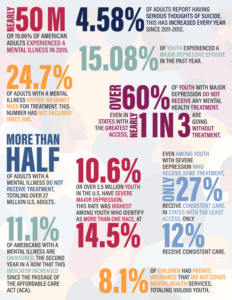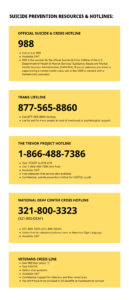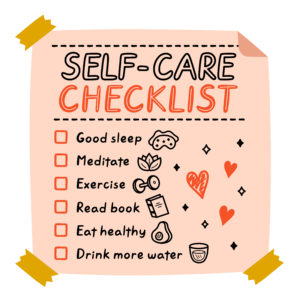
Just as we care for our households, our pets and our physical health, it’s important to also take care of our mental health and wellness. Mental health can present itself in many ways and is unique to each person’s experience. For children and adolescents, understanding and expressing their emotions can be particularly challenging. This especially holds true when there are compounding social stressors out of children’s and teenagers control, such as the COVID-19 pandemic.
The Truth Behind Youth Mental Health
According to the National Alliance of Mental Health, “1 in 6 U.S. youth aged 6-12 experience a mental health disorder each year” and “50% of all lifetime mental illness begins by age 14.”
More severely, “Suicide is the second leading cause of death among people aged 10-34.” As parents and caregivers, it’s important to recognize the signs that your child might be struggling with their mental health and more acutely, knowing what you can do to help. Children and adolescents may be reluctant to share if they are struggling due to fear of embarrassment, feeling there is something wrong with them, or not wanting their parents or caregivers to worry.
Part of supporting your child with their mental wellness is also fighting against the stigma around mental health, and assuring your child that they are not alone. Resources and support are available.
Warning Signs of Mental Health Issues in Children & Teens
Our clinical team recommends keeping an eye out for the following signs that your child may be struggling with their mental health. It is important to keep in mind that while both children and teens may experience similar symptoms, due to their developmental differences the presentation of these symptoms can appear very differently.
For example, younger children who are still learning to identify and express their emotions might gravitate more towards behavioral representations of how they feel, such as having temper tantrums. Teens, on the other hand, might experience their feelings on a more global scale, such as questioning their world or feeling a lack of security amongst others.
Children (and teens) may be experiencing an increase in anxiety and depressive symptoms. This can impact their school performance, sleep patterns, eating habits, and their ability to self-regulate their emotions. For instance, some children might present as more hyperactive or become increasingly irritable and present a low mood.
Additionally, they may have a lower tolerance for stressors, difficulty concentrating on tasks, and report physical ailments such as headaches or stomach aches. In some cases, children might struggle to practice personal hygiene, or they might seem overly obsessive with cleanliness or completing other daily rituals. Lastly, your child may talk about or think about death, or they may make comments such as “I wish I wasn’t here anymore.” Take notice of these statements and seek support if you have concerns.
Teens may also experience more profound mood changes beyond what is considered developmentally typical. For instance, they may present unusual “highs” and “lows” in their mood for periods of time.
Other symptoms may include:
- Feeling numb (internally and in how they relate to others)
- Thinking or talking about suicide
- Showing increased Isolation from social events or usually preferred activities
- Exhibiting poor decision making
- Exhibiting an increase in risky behaviors—such as misuse of substances, unsafe sexual behavior, limiting food intake, aggression, illicit activities or self-harming
- Hearing, seeing, or feeling things that are not really there, also known as hallucinations or delusions
- Struggling with navigating their growing independence, which may be impacted by low self-esteem or excessive worrying

How to Support Your Child’s Mental Wellness
Being a parent and caregiver is a big job, but you don’t have to do it alone! There are many tips and tools to help promote mental wellness in your household and supportive mental health professionals are available if needed. Building your awareness of childhood mental health is a great first step. Our clinical team has gathered some helpful tips and tools to support you and your child through this journey.
Talk It Out
Practice talking with your child about their mental health. Part of breaking the stigma that having a mental health condition means there’s something wrong with them involves normalizing your child’s experience and reassuring them that they are not at fault. Create an open, safe space for your child to explore their feelings without fear of shame or judgment. Let your child know that it’s okay to not be okay.
Active Listening
A big piece of healthy communication also includes actively listening to what the other person is saying. Observe not only what your child is saying out loud, but also take note of their tone of voice, body language, facial expressions and the meaning behind their words. Practice asking open-ended questions, such as “how did that make you feel?” rather than leading questions, such as “did you feel angry when she said that?”
Show your child that you’re curious and interested in what they have to say. Validate their feelings, even if you don’t personally agree with them. Showing someone that you understand their experience helps to build trust and does not necessarily mean you are condoning any types of behaviors.
Role Model
Parents and caregivers are often the first role models children experience. Practice modeling for your child how to express emotions in a healthy way, including when you feel happy, angry, or sad. Consider talking about your own experiences with your children, such as sharing coping strategies that you have personally found helpful. Let your child see you ask for help, even for the little things, to show them that reaching out to others can be a sign of strength. Practice your own self-care and create a self-care plan for your child.
Routines
Having clear and consistent routines and expectations helps to promote a safe environment for your child. Particularly when there are stressors out of the child’s control, having a predictable daily routine helps to promote healthy habits across the board and mitigates unnecessary worrying. This might include having set meal times, sleep schedules and transition plans, as well as knowing what is allowable and thus what consequences might be put into effect.
Celebrate Strengths
Highlight your child’s many strengths, even during the hard times. Encourage your child’s talents and skills. Engage them in positive outlets, hobbies and opportunities for social connections. Acknowledge both the good and bad times. Celebrate your child’s accomplishments while also being fair with consequences for misbehavior.
Final Thoughts & Additional Resources
Here are some additional resources with information on mental health risks, warning signs, and available support:
If your child is experiencing challenges with their mental health, consider reaching out for additional support.
Here are some helpful resources that you or your child can use:
- NAMI HelpLine
- Call #1-800-950-NAMI (6264), text #62640, chat nami.org/help or email HelpLine@nami.org
- National Suicide Prevention Lifeline – Call 800-273-TALK (8255), available 24/7
- Crisis Text Line – Text NAMI to 741-741
- Connect with a trained crisis counselor to receive free, 24/7 crisis support via text message.
- National Crisis Text Line- Call or text 988 or chat at 988lifeline.org
- Connect with a trained crisis counselor. 988 is confidential, free, and available 24/7.
If you feel your child may need to speak with a professional for ongoing care, your primary care provider and/or insurance plan can be a good place to start for referrals. Valera Health also offers telemental health for children and adolescents, including individual therapy and psychiatry services. Visit www.valerahealth.com to or click here to request a consultation.

















 In addition to emergency suicide resources, therapy can play a key role in recovering from suicidal thoughts, depression, anxiety and other mental illnesses and mental health issues.
In addition to emergency suicide resources, therapy can play a key role in recovering from suicidal thoughts, depression, anxiety and other mental illnesses and mental health issues.











